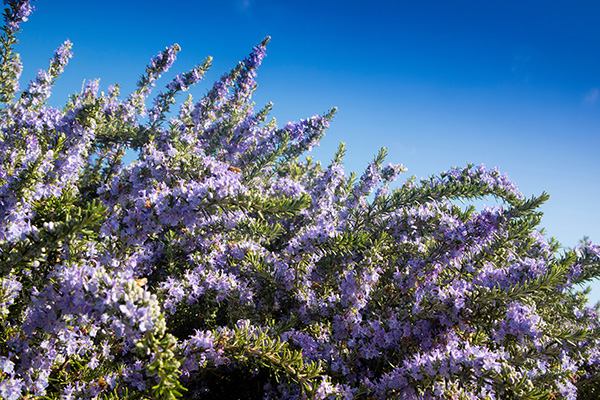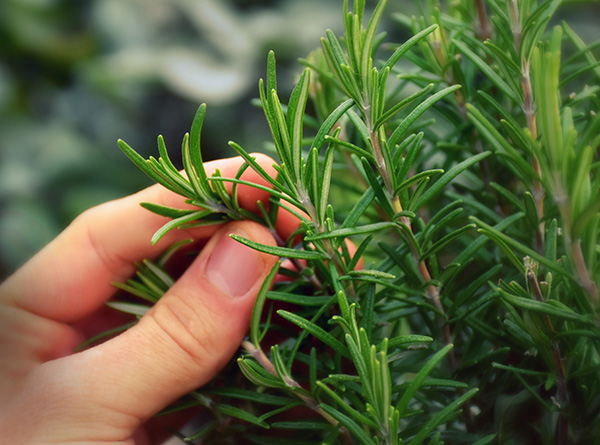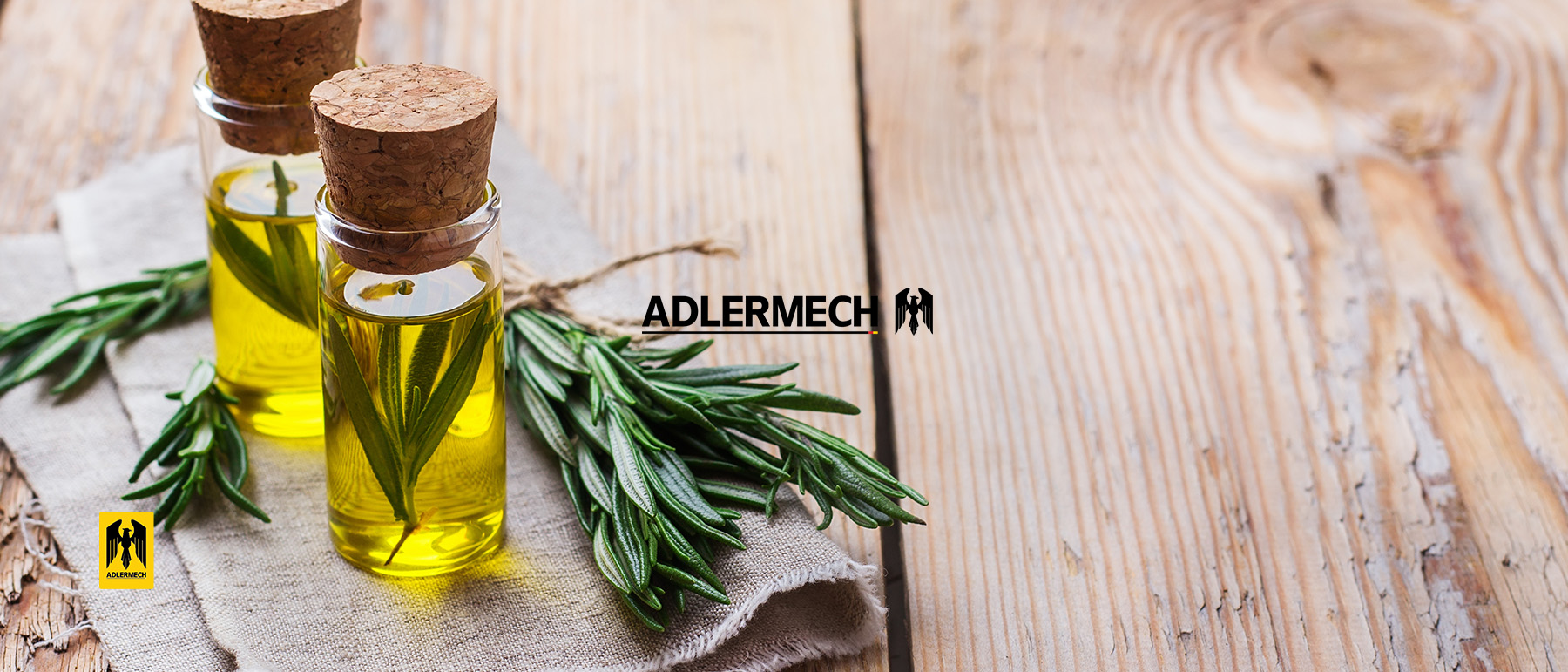The average rosemary yield is 20 tons per hectare (1 hectare = 10,000 square meters, 1 ton = 1000 kg). But the difference with the “Dried: Fresh” harvest is 1:3. Thus, the average yield of the dried harvest is 6.7 tons per hectare.
However, the figures above are valid for the product obtained by distilling the whole plant (stem/branch and leaf). The yield of the dried leaf harvest is 2.5 tons per hectare. The average essential oil yield is close to 0.3% of the total plant harvest. As a result, you can achieve an average yield of 60 kg of essential oil per hectare.
Please note that the above figures represent the average annual yield and also these figures are obtained when harvesting healthy and mature (over 3 years old) plants grown by professional breeders. Yield is highly dependent on many parameters (variety, climate, soil, fertilization, irrigation, weed control, harvesting, distillation methods, etc.), so these figures vary from grower to grower.
How to Grow Commercial Rosemary?
Fresh rosemary, dried rosemary, or essential oil commercially has become a new trend in agribusiness in the last 20 years. This is because rosemary essential oil is used in various industries today and is in increasing demand (sometimes with difficulty). The second reason is that while the plant rarely suffers from diseases, it is quite easy to grow this plant. After obtaining healthy and mature plants, more than ten years of good yields can be obtained. Also, as with all commercial crops, you need to do research on rosemary varieties in particular. Our rosemary plants will produce dried rosemary or essential oil for the next 10-15 years, so we have to ensure that we have selected a variety that suits the demand of the target market. For example, professional producers who supply pharmaceutical factories or wholesalers grow varieties that the customer specifies or wants.
Rosemary is a hardy herb and can grow in almost any well-drained soil; however, there are some specific climate and soil requirements. In general, rosemary can be grown without an artificial water supply or soil fertilization, but a number of practices are required to grow rosemary commercially. Planting, Irrigation, Fertilization, Weed Control, and Harvesting are the most important practices because they highly affect the yield. These activities represent a large part of the cost. Storage and distillation methods are also extremely important for the amount and quality of essential oil.

Climate, Soil Requirements, and Soil Preparation of Rosemary Herb
Rosemary – Climatic demands of rosemary herb
Rosemary is a plant that needs at least 6-8 hours of sunlight per day and prefers hot and moderately arid climates. It is grown locally in Mediterranean countries where an average temperature of 20-30 ° C is expected in late spring and early summer. Soil temperatures above 18°C encourage growth and re-sprout after harvest. Also, this plant can withstand low temperatures as it is hardy.
Rosemary – Soil requirements and soil preparation of rosemary herb
Rosemary plants can grow in well-drained soils with a pH between 5.5 and 8. However, high yields are generally obtained in light-textured, sandy soils with a pH value close to 7 and with good drainage.
Before making soil preparation, it is necessary to analyze the soil and measure the pH value as the first step. In order for the pH value of the soil to be at the desired levels, it is necessary to lower or increase the pH value depending on the situation (6.8-7.5). In addition, soil analysis also diagnoses any nutrient deficiencies so that the farmer can consult a licensed agronomist to take necessary actions to balance the nutrient ratio. In most cases, it will be beneficial to fertilize with 10 tons of well-combusted manure per hectare and to till the field well before planting the young rosemary seedlings. When diagnosing a high level of nutrient deficiency, farmers usually fertilize the soil at the time of planting the young seedlings or a few weeks before planting by watering the soil N-P-K 20- They apply 20-20 (180 kg per hectare). However, these recommendations are just general patterns and are not recommended unless you do research on your soil.
Fertilization in Rosemary Grass Cultivation
As with all other crops, there can be no exact fertilization rule because every field is different and therefore has different needs. With the help of a licensed agronomist, it is extremely important to conduct a soil analysis and diagnose nutrient deficiencies once a year to make the necessary applications.
Generally, the plant will need Azota, Phosphorus, Potassium, Sulfur, and Magnesium in order to ensure the development of rosemary herb for more than ten years and at the same time to achieve high yields. Most of the time, especially when nitrogen fertilization is done after harvest, the plant responds positively to this application. Because this practice encourages re-sprouting and development. However, excessive nitrogen fertilization adversely affects the quality of the essential oil.
There is a common fertilization program that most former farmers apply, according to which 318 kg of N-P-K 12-12-17+ 2MgO fertilizer per hectare per year (1 hectare = 10,000 square meters). Normally, this amount is usually divided equally for 2 or 3 applications; The first fertilization is done immediately after harvest.
Organic rosemary growers, on the other hand, usually fertilize with 15-20 tons of burnt manure per hectare and plow the field well before planting the young plants. Then they apply 5-10 tons of fertilization per hectare each year in autumn. After each fertilizer application, the soil is processed and watered. According to the characteristics of organic agriculture, they fertilize 200 kg of potassium sulfate (K2SO4) per hectare.
However, it is not recommended to follow these suggestions above without researching your soil because every field is different and therefore has different needs.

How to water rosemary grass?
Rosemary grass is a drought-tolerant herb. However, when grown commercially, it is helpful not to allow the soil to remain completely dry for long as this will adversely affect the plant’s production.
There are two rules about watering rosemary herbs. The first rule is that newly planted plants (plants from seed or cuttings) need more water than mature plants. Young plants need artificial water sources to develop a strong root system. After this period, mostly mature plants can meet their water demands and grow without irrigation, provided that the annual precipitation is above 450 mm. This also depends on soil texture and moisture levels. The second rule is that rosemary herb often suffers from root rot and fungal diseases due to excess water. As a result, we must be careful not to over-water.
Most rosemary herb growers irrigate 3-4 times during the summer in hot and dry regions. In addition, especially in summer, irrigation can be done once a week for 20 minutes with the drip system.
Weed Control in Rosemary Cultivation
Unfortunately, rosemary grass often suffers from weeds that compete with plants for space, access to sunlight, water, and nutrients. The presence of weeds will adversely affect the amount of fresh herbs harvested as well as the quality of the essential oil. The weed control procedures applied by all rosemary herb growers may differ significantly due to various factors such as country, regional climate, law, production tools, target market of production, but every farmer should have a valid weed control strategy.
Before planting the seedlings, the first measure is taken against weeds by plowing the field. The second important step in weed control is to work the soil between the plant furrows by hand frequently. Above the plant furrows, healthy mature lavender plants normally do not allow weeds to grow if they are planted at close distances. However, professional rosemary herb growers regularly check for the presence of weeds on the furrow and, if necessary, carefully remove the weeds by hand.
When and How to Harvest Rosemary Herbs?
Most rosemary growers do not harvest rosemary for the first 15-21 months after planting plants. From the second year, they harvest once or twice a year.
As a general rule, if you are growing rosemary for dried rosemary, you may need to prefer young branches/stems and harvest twice a year or more to encourage regrowth.
If you are growing rosemary for its essential oil (essential oil), knowing exactly when to harvest is essential for the quantity and quality of the essential oil. This is a subject in that you will gain experience by doing extensive research and by constant trial and error. First, you have to decide whether you want to produce essential oil from just the leaves, flowers, stems, or all (distilling the whole plant). By distilling the stems and leaves, you can get a higher amount of essential oil but of lower quality than the flowers.
Most professional rosemary growers reported that when they harvested leaves and stems before flowering, they obtained high-quality essential oil from this harvest, while harvesting stems and leaves after flowering mostly produced more aromatic products. However, these aforementioned practices are not recommended unless you do your own research on the matter. Also, some growers wait for the plants to bloom and then just harvest the flowers, and distill this harvest, reporting a high quality but low amount of essential oil.
In many countries, rosemary harvesting is done mechanically with machines attached to tractors. These machines cut the stems to predetermined lengths to encourage regrowth. In developed countries, growers harvest rosemary manually. They cut the stems of rosemary herbs with special knives and let them dry by leaving them in the sun for 2-3 days, in term of that it does not rain.

Leave a Reply